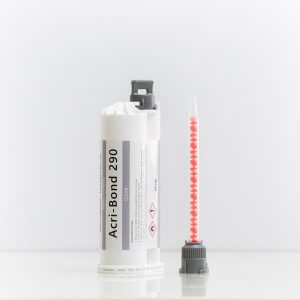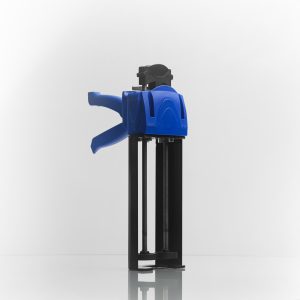Product and Use Type
ACRIFIX 190 is a two-component polymerisation adhesive. Clear, purplish viscous solution of an acrylic polymer in methyl methacrylate. Which polymerises completely upon addition of CATALYST 20.
Applications for ACRIFIX 190
ACRIFIX 190 is preferably used for bonding acrylic (PMMA), i.e. PLEXlGLAS® GS, PLEXIGLAS® XT or parts made from PLEXIGLAS® moulding compound, with one another, but also for other materials such as ABS, CAB, PS, PVC, SMS, UP and wood. The cured joints are almost colourless.
Typical Values of ACRIFIX 190
Viscosity; Brookfield II/12/20°C: 1800± 200 mPa•s.
Density/20°C: ˜1.02 g/cm3.
Refractive index nD20: ˜ 1.44.
Colour: clear, slightly purplish.
Flash point DIN 53213: ˜ 10°C.
Solids content: 31 ± 1%.
Storage stability: 2 years after filling, if correctly stored.
Working Instructions for ACRIFIX 190
Preparing the Parts to be bonded Degrease the surfaces to be bonded with water containing a wetting agent (washing-up liquid). Or you are able to use a THINNER AND CLEANER 30. Internally stressed parts must be annealed before bonding in order to avoid stress cracking. The annealing conditions depend on the type of material, the degree of forming and the thickness of the parts to be bonded. Parts made of extruded and injection-moulded acrylic should be annealed as a matter of principle. Typical annealing times – also for cast acrylic – are 2 to 4 hours in an airflow oven at 70 to 80degC. These presuppose that the surfaces to be bonded are flat and without V-grooves or superimposed layers, however.
Preparing the Adhesives
Add 3 to 6% CATALYST 20 to ACRIFIX 190 and stir until no more striation is visible. In the covered container, air bubbles may be allowed to rise to the surface of the adhesive, but they can also be removed in a vacuum desiccators (min. 200 mbar). As soon as the ACRIFIX® 190 mixture becomes thick and noticeably warm (end of pot life), it should no longer be used.
Bonding Technique
Fix the parts to be bonded in the desired position and apply suitable adhesive tape to seal the joint and to protect surrounding areas (see drawings). Introduce ACRIFIX® 190 into the joint either directly from the mixing vessel or by means of a glue dispenser or disposable syringe, and avoid bubble formation.
Other Measures
Roughening-up with abrasive paper (grit 230 to 320) improves the adhesion to untreated surfaces of cast acrylic (particularly block material). Severely stressed bonds or those intended for outdoor exposure should be annealed for 2 to 4 hours at 70 – 80degC immediately after curing. ACRIFIX® 190 must not get into closed cavities (e.g. double glazing, tube interiors). Since the curing process is severely hampered at such sites, and there is a risk of stress cracking in the bonded parts.
Properties of ACRIFIX 190 Bonds
Further treatment of bonded parts: 2 to 6 hours after curing.
Tensile shear strength (v = 5 mm/min): The bonds only acquire their final strength after about 24 hours or after immediate annealing as soon as the adhesive has cured.







